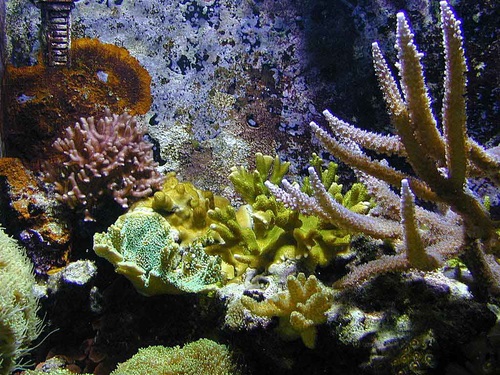TRENDING: ADDING LED MOONLIGHTS TO THE AQUARIUM

Updated
With advances in aquarium lighting technology, you now have the option to add specialized nighttime lighting to your aquarium. LED moonlights are perfect for nocturnal species of fish or simply to enhance the nighttime appearance of your tank.
While the majority of aquarium fish are diurnal (active during the day), there are certain species which tend to be most active at night. If you have a community tank that is primarily comprised of diurnal fish, your nocturnal fish may be neglected. To meet the needs of your diurnal fish, you probably keep your aquarium lights on for 10 to 12 hours per day, leaving your nocturnal fish in complete darkness overnight. While keeping regular aquarium lights on overnight is not recommended, there is a new option available specifically designed to meet the needs of nocturnal fish – LED lunar lighting. In this article you will learn the basics about this type of lighting including what it is, how it benefits your fish, and what you need to do to install it in your own aquarium.
What are LED Lunar Lights?
If you have never used LED lights in your aquarium, you are missing out – they are one of the newest and most popular options in modern aquarium lighting. Not only are LED lights very powerful, but they are also incredibly energy-efficient – in fact, they produce up to 8 times as much light as fluorescent lights per watt of electricity used. This alone makes LED lights worth using because they will save you a lot of money – they also last for up to 7 years. Another benefit of LED lighting is that it does not produce as much heat as other types of aquarium lighting that produce a comparable intensity.

LED lunar lights are a specific type of LED lighting designed to simulate the wavelength of moonlight. In reality, moonlight is simply reflected sunlight and its intensity changes depending on certain atmospheric conditions. In the past, aquarium hobbyists have attempted to simulate the waxing and waning of the moon by using blue filters over traditional aquarium lighting or even by using blue Christmas lights. The development of lunar LED lighting renders these techniques obsolete and gives you an inexpensive and effective option for nighttime aquarium lighting.
Benefits of Lunar LEDs
Nocturnal species of aquarium fish tend to spend most of the day hiding, coming out only at night when the lights have turned off to feed. Many species of nocturnal aquarium fish actually become quite stressed by bright daylight and they are unlikely to exhibit natural behaviors in this type of lighting. LED lunar lighting, on the other hand, simulates natural moonlight and thus encourages nocturnal species of fish to exhibit natural nighttime behaviors. Using LED lunar lights in your tank allows you to view your nocturnal species of fish without disturbing them – some LED lunar lights even create a sparkling effect in the tank water, adding to the tank’s aesthetic appeal.

Another important benefit of Lunar LED light applies specifically to saltwater and reef aquariums. Moonlight triggers natural biological activities, both internal and external, for a variety of reef-dwelling creatures and it plays a very important role in the growth and spawning of corals, specifically. While daylight is important for the healthy growth of corals, many species continue to grow in the moonlight and, for some species, reproduction only occurs at night. If you plan to keep live corals in your tank, you should definitely look into some lunar LED lighting.
Using LED Lunar Lights in Your Tank
Incorporating LED lunar lights into your tank may be easier than you think. If you pay a visit to your local pet store and peruse the aquarium lighting aisle, you will find an array of nighttime lighting options. If you compare the price and wattage of the various options, however, you will find the LED lunar lights are the most cost-effective. Your options will vary greatly from dual-function LED fixtures that incorporate both daytime and nighttime LED light to dedicated lunar LED fixtures. Remember, LED lights are much brighter and more intense than standard or compact fluorescents, so you do not need a very large fixture unless you have a very large tank.
After you have chosen your lunar LED fixture and installed it in your tank, you need to think about how you are going to use it. Most aquarium hobbyists recommend 12 hours of daylight and 12 hours of lunar light. In order to accomplish this, you may want to invest in an automatic timer – this is the easiest way to automate the switch from daylight to moonlight in your tank without having to worry about turning the lights on and off yourself every day. Automatic timers are inexpensive and easy to use, so you really have nothing to lose.
In reading this article you have learned the basics regarding what LED lunar lighting is and how it can benefit your tank. If you have nocturnal species of aquarium fish in your tank, or if you are considering adding some, you should definitely look into adding a lunar LED fixture to your tank – your fish will thank you!
comments powered by Disqus











































